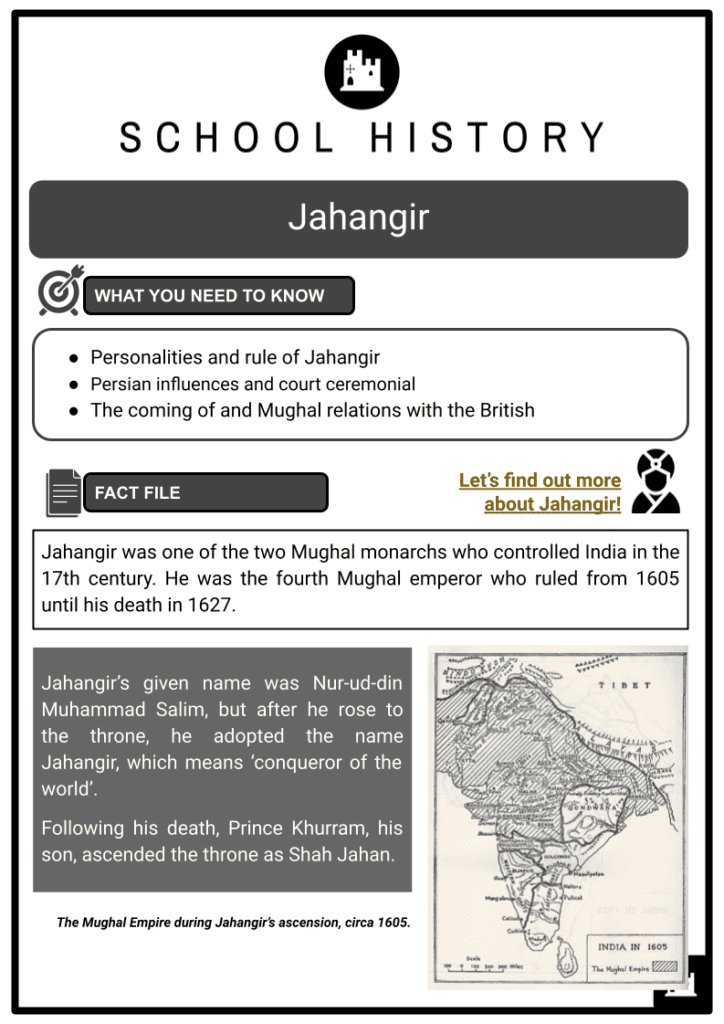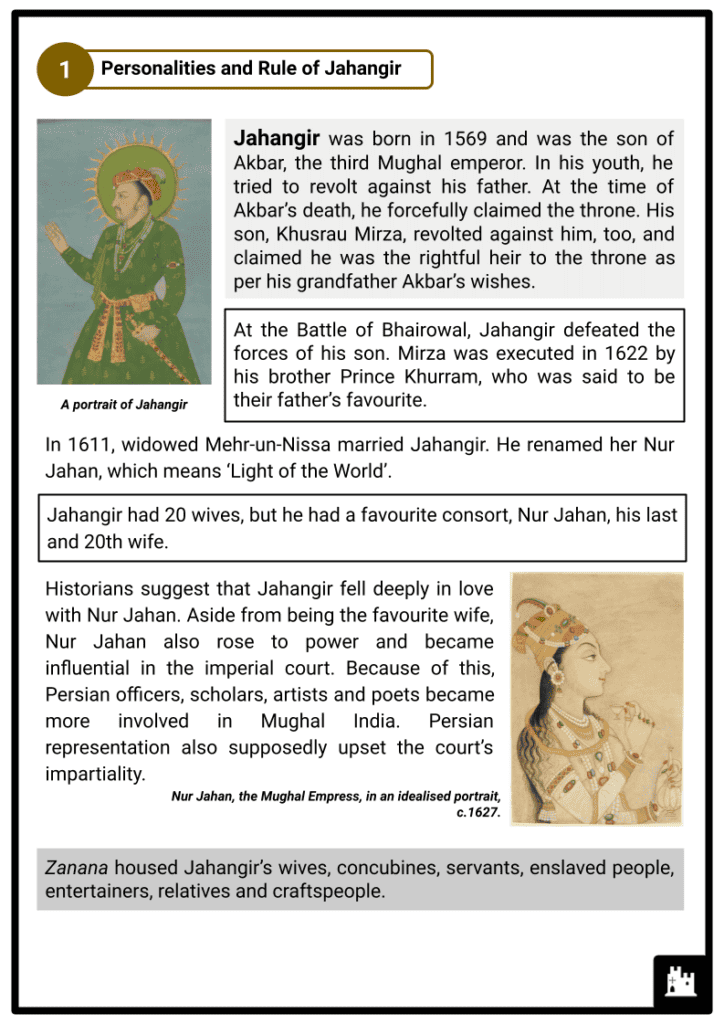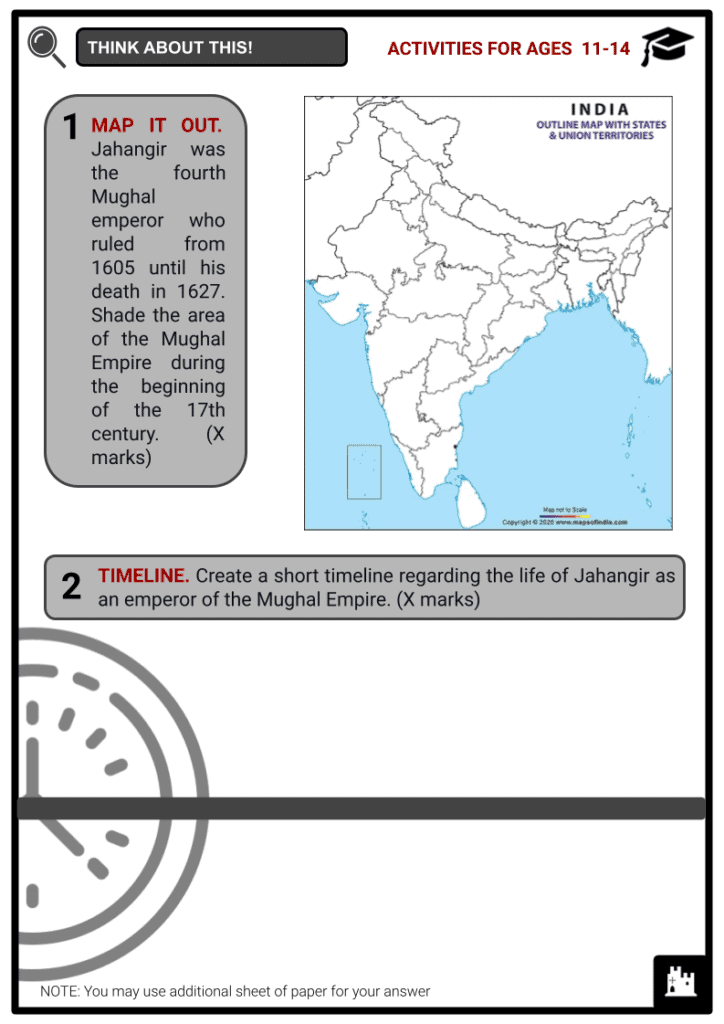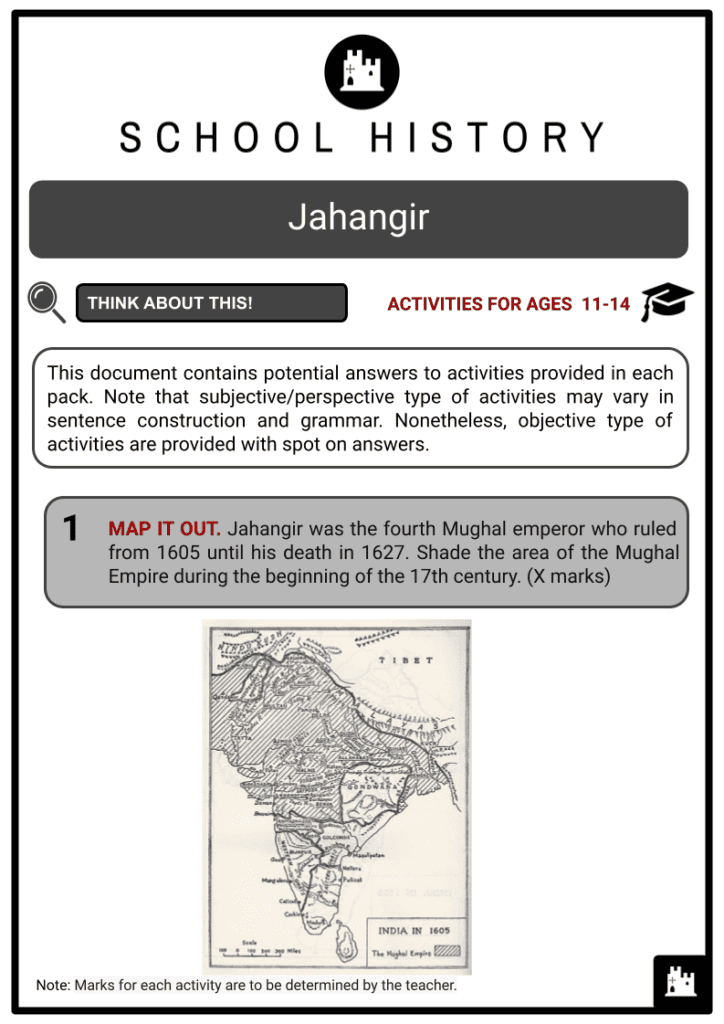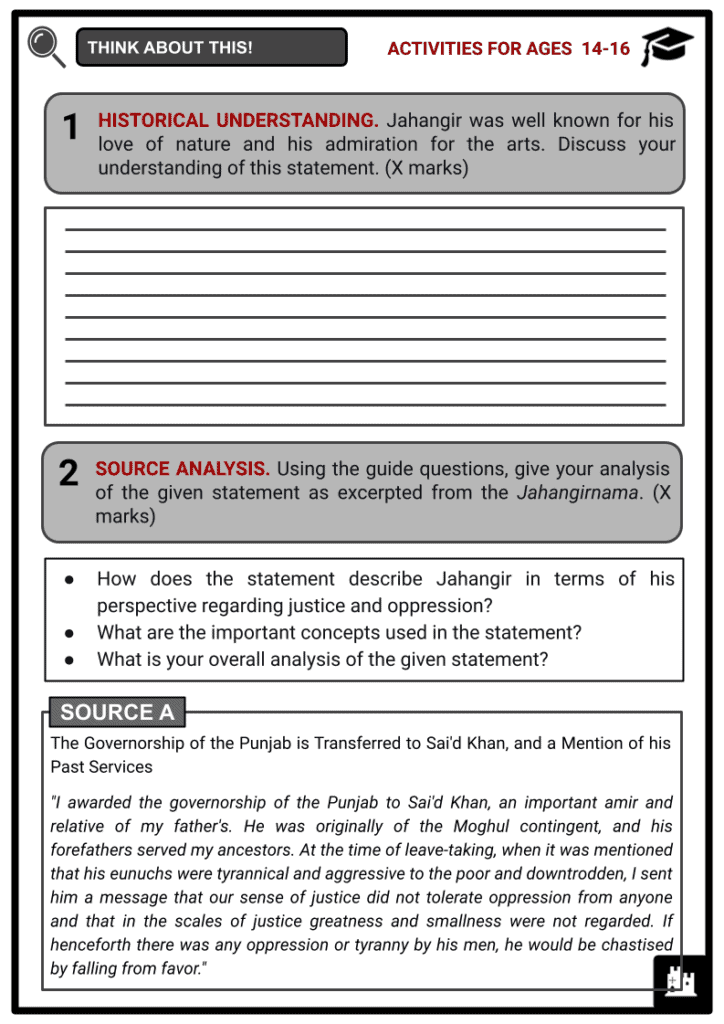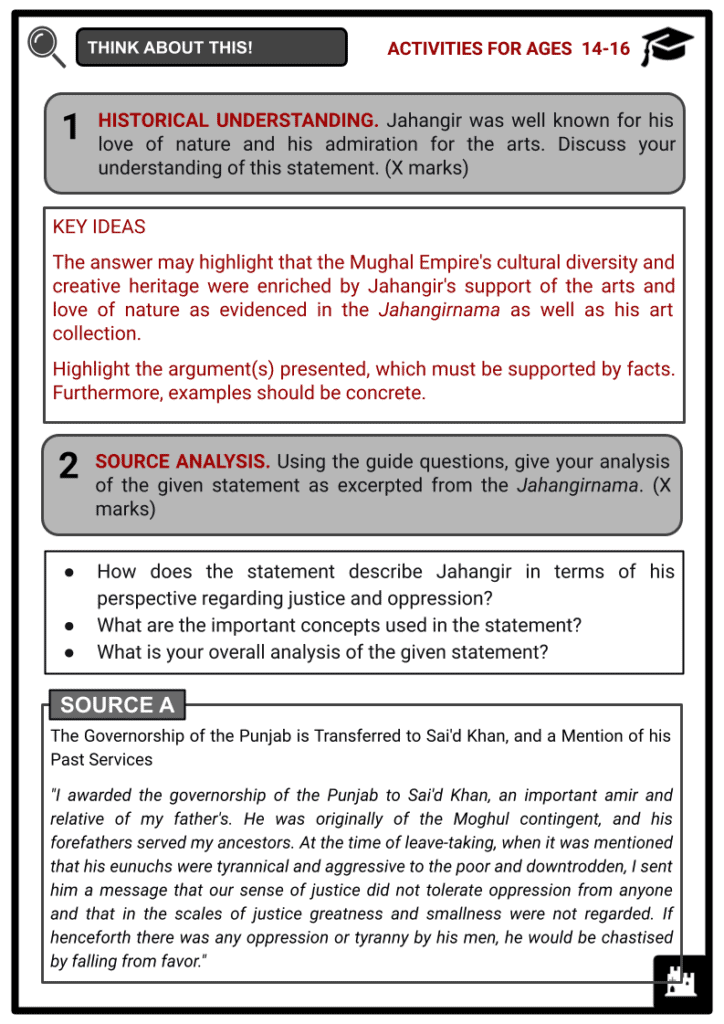Jahangir Worksheets
Do you want to save dozens of hours in time? Get your evenings and weekends back? Be able to teach about Jahangir to your students?
Our worksheet bundle includes a fact file and printable worksheets and student activities. Perfect for both the classroom and homeschooling!
Summary
- Personalities and rule of Jahangir
- Persian influences and court ceremonial
- The coming of and Mughal relations with the British
Key Facts And Information
Let’s find out more about Jahangir!
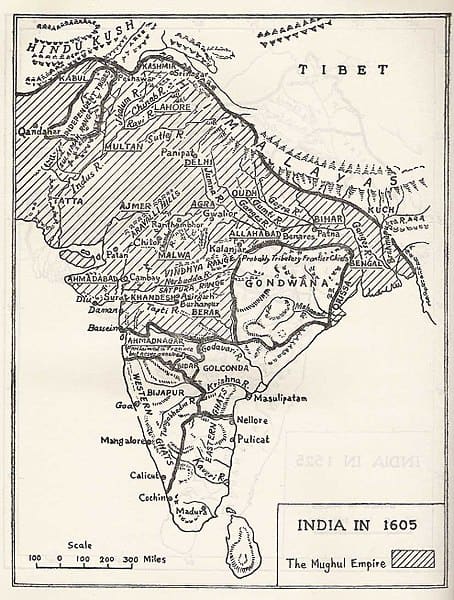
Jahangir was one of the two Mughal monarchs who controlled India in the 17th century. He was the fourth Mughal emperor who ruled from 1605 until his death in 1627. Jahangir’s given name was Nur-ud-din Muhammad Salim, but after he rose to the throne, he adopted the name Jahangir, which means ‘conqueror of the world’. Following his death, Prince Khurram, his son, ascended the throne as Shah Jahan.
Personalities and Rule of Jahangir
- Jahangir was born in 1569 and was the son of Akbar, the third Mughal emperor. In his youth, he tried to revolt against his father. At the time of Akbar’s death, he forcefully claimed the throne. His son, Khusrau Mirza, revolted against him, too, and claimed he was the rightful heir to the throne as per his grandfather Akbar’s wishes.
- At the Battle of Bhairowal, Jahangir defeated the forces of his son. Mirza was executed in 1622 by his brother Prince Khurram, who was said to be their father’s favourite.
- In 1611, widowed Mehr-un-Nissa married Jahangir. He renamed her Nur Jahan, which means ‘Light of the World’.
- Jahangir had 20 wives, but he had a favourite consort, Nur Jahan, his last and 20th wife.
- Historians suggest that Jahangir fell deeply in love with Nur Jahan. Aside from being the favourite wife, Nur Jahan also rose to power and became influential in the imperial court. Because of this, Persian officers, scholars, artists and poets became more involved in Mughal India. Persian representation also supposedly upset the court’s impartiality.
- Zanana housed Jahangir’s wives, concubines, servants, enslaved people, entertainers, relatives and craftspeople.
- As a result of Nur Jahan’s influence over Jahangir, the following events happened:
- The empress’ father attained a high position in the Mughal government.
- Nur Jahan’s brother, Abu Hasan Hasaf Khan, gained power in the emperor’s entourage.
- Abu Hasan Hasaf Khan’s daughter, Mumtaz Mahal, married Jahangir’s son and successor, Shah Jahan.
- Among Jahangir’s goals was the conquest of Mewar, which his father failed to subdue. In 1615, a peace treaty was signed between Rana and Jahangir after a successful military attack on Mewar.
- In contrast to his success in gaining control of Mewar, Jahangir failed to gain immediate full control of Ahmednagar, a region in south India. Despite its resistance, Ahmednagar accepted a treaty with the Mughal Empire. As a result, a number of forts and the area of Balaghat were given to the Mughals.
- In 1620, the Mughals broke the treaty when they besieged the Ahmednagar fort.
- Jahangir was a liberal and tolerant king who held a high regard for the customs and cultures of the people he oversaw. He was well-known for his pro-religious tolerance policies and aggressively promoted discussion and interaction across many faiths. In addition, he was a just leader who worked to guarantee that his people received respect and fair treatment.
- However, Jahangir also possessed a harsh side and was reputed to be capable of great severity when dealing with his adversaries. Additionally, he had a reputation for being rather indecisive and susceptible to other influences. Despite these shortcomings, Jahangir is regarded as one of the Mughal dynasty’s more progressive and cultured kings.
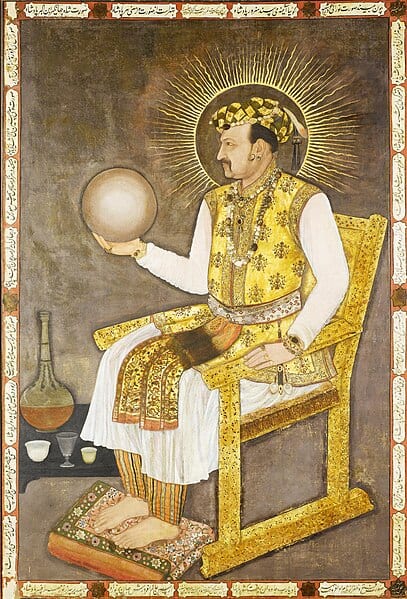
A portrait of Jahangir by Abu al-Hasan, c.1617. - While Jahangir adored Hindu festivals, he also encouraged mass conversion to Islam. The emperor also ordered the killing of Guru Arjun Dev, the Sikhs’ fifth saint-teacher. Guru Arjun was a known supporter of Prince Khusrau, an heir to the Mughal throne, who participated in the civil war that occurred following Akbar’s passing.
- In 1620, 52 Hindu princes were released from captivity, the importance of which is signified by the Sikhs’ Diwali festival.
Persian influences and court ceremonial
- Persian influences and court rituals were very important in the Mughal courts in Jahangir’s rule. This was primarily because he was enamoured of Persian culture and had travelled to Iran before taking the throne.
- Persian influences were particularly prevalent during Jahangir’s reign because a large number of Persians held important military and administrative positions at the Mughal court.
- Jahangir avidly fostered Persian literature and culture during his reign and was a superb Persian poet himself. Additionally, he paid for numerous translations of Persian texts into the Mughal court language, which was a mix of Hindi and Persian.
- Jahangir was well known for his love of nature and his admiration for the arts. Additionally, under his leadership, the Hindu majority in India benefited from his liberal policies, which promoted religious harmony.
- Jahangir was renowned for having an intricate and varied personality. He was a very well-educated and well-cultured man who had a strong passion for philosophy, literature and the arts. He frequently wrote about his adventures and observations in his memoirs.
- Following his predecessor’s initiative, Jahangir collected his personal memoirs, including narratives and works of art. Compared to all Mughal emperors, Jahangir was the most visual and observant of the world around him. Compared to his father, Akbar, who initiated extensive public building projects, Jahangir focused on the beauty of architecture and illustrations.
- In the Tuzuk-e-Jahangiri or Jahangirnama, the emperor described the landscapes he witnessed in India, including gardens, trees, animals and temples.
- Largely influenced by Western painting, Jahangir ordered his painters to make reference to Western styles in his portraits. As a result, Mughal painters adapted finer strokes and lighter colours. Among the earlier Mughal emperors, Jahangir had direct contact with the English Crown. He received gifts of oil paintings, specifically portraits.
- Mughal miniature paintings covered a variety of subjects, including court scenes, battles and portraiture. Most were painted with ornate borders and calligraphy.
- Compared to the regular form of paintings, as its name suggests, miniatures were quite small yet filled with detail. Usually, multiple artists worked on creating a single miniature painting.
- Art historians suggest that the height of Mughal painting was achieved during the rule of Jahangir. Abul Hasan, son of the Iranian artist Aqa Reza, became one of his most valued court artists. Jahangir commissioned paintings of rare birds from Goa and flowers in Kashmir, which reflected Naturalism.
- In addition to India’s marvellous landscape, most Mughal paintings during Jahangir’s reign depicted battles and the presence of foreign emissaries who aimed to establish trade connections. The Mughal way of life was greatly told through their paintings.
- In general, Mughal painting was a combination of Indian, Persian and Muslim styles in which the major features included the following:
- Subjects based on close observation of nature.
- Refined and intricate drawings along with calligraphic text descriptions, usually on the border.
- Primarily aristocratic in nature and mostly secular.
- Ustad Mansur, one of Jahangir’s court artists, was best known for his paintings of a Siberian crane and the dodo bird, both of which are now extinct.
The coming of and Mughal relations with the British
- King James I dispatched Sir Thomas Roe, an English ambassador, to the Mughal court in 1615, during Jahangir’s rule. His main objective was to negotiate advantageous terms for British traders and to arrange an agreement between the East India Company and the Mughal Empire. Jahangir enthusiastically welcomed Roe at first, and the two men became good friends. Roe’s proficiency in Persian and Turkish won Jahangir over, and the two men spoke for hours on politics, religion and culture.
- Jahangir started to view the British more favourably as a result of Roe’s influence. By 1615, a company was finally set up in India that was bound to send Indian textiles from Surat to Bantam and in 1616 he gave the East India Company permission to build a factory in Surat. Jahangir was careful to safeguard Mughal interests in all commercial arrangements, but he also continued to be wary of the British.
- By the early 17th century, the Mughal Empire that covered northern and central India likely held the centre of power of the world’s civilisations. A hundred years prior to the establishment of the English East India Company, the Portuguese had direct trade with India.
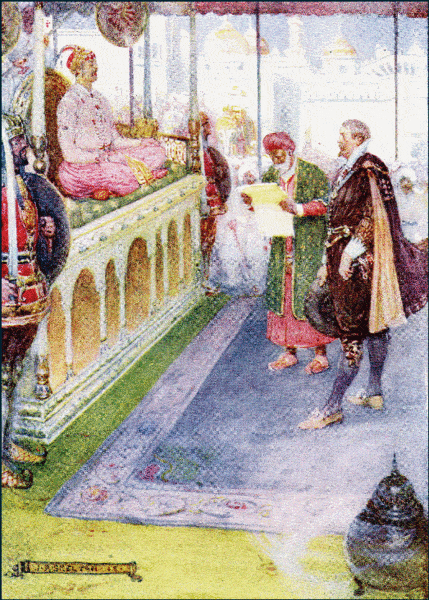
An illustration of Sir Thomas Roe standing in front of Jahangir. - With initial trading conflicts against other European countries, including, Portugal, France, the Netherlands and Spain, England failed to establish a trade monopoly in India. After gaining Mughal patronage, the English finally ousted Portuguese traders.
- Prior to foreign trade, the Mughal Empire was highly dependent on agriculture. Among their major crops were millets, oil seeds, cereals, sugar cane, indigo and cotton. It was Babur who initiated the first cultivation of Asian fruits in India. At the time of Akbar, textile industries gained a market.
- During Jahangir’s reign, cultivation of tobacco and potato were introduced by the Portuguese. In his eighth year as emperor, Jahangir issued a silver Nazaran Rupee minted in Agra. Lahore, Delhi, Agra and Ahmedabad became leading cities of trade in the world. In return, the Mughal Empire imported gold, silver, horses, metals, precious stones, and enslaved African people.
- The East India Company, incorporated by royal charter in 1600, was originally forced to share the East Indian spice trade. Following the defeat of the Portuguese, the EIC gained a trading partnership with the Mughal Empire under Jahangir in 1612. By the 1620s, slave labour became the backbone of the EIC. Enslaved people were traded from Southeast Asia and West Africa.
- It was Queen Elizabeth I who granted hundreds of English merchants the right to trade in the East Indies, in 1600. The Mughals and the British were at odds by the time Shah Jahan assumed leadership in 1628. With a sizable foothold in India, the East India Company had started to dominate the country’s merchants and local rulers. By the middle of the 17th century, they had secured a large amount of control over the Indian textile trade after opening a plant in Madras.

